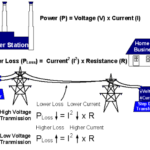Difference between KWh and KVAh?
KVAh and kWh are two different units of energy that are used to bill customers for electricity usage.
KWh (Kilowatt-hour) is the unit of measurement of energy consumed over time. It is calculated by multiplying the power in kW (Kilowatts) by the time in hours. It represents the actual amount of energy consumed by a customer during a billing period. For example, if a customer uses a 1 kW appliance for 10 hours, they would consume 10 kWh of energy.
KVAh (Kilovolt-ampere hour) is the unit of measurement of the apparent power in an electrical system. It is a measure of the total power consumed by an electrical system, including both the useful power (kW) and reactive power (kVAR). Reactive power is the power that is required to maintain the voltage level in the system. It does not perform any useful work but is required for the proper functioning of the system.
In some cases, the utility companies may charge customers for the KVAh consumed, especially in cases where the electrical system has a low power factor. A low power factor means that a significant portion of the power is being wasted due to reactive power, which can result in increased system losses. Charging customers based on KVAh helps to encourage them to improve their power factor and reduce their energy consumption.
In summary, while kWh is a measure of the actual energy consumed by a customer, KVAh is a measure of the total power consumed by an electrical system. The choice of which unit to use for billing depends on the specific circumstances and the objectives of the utility company.
how we can measure KWh and KVAh billing?
To calculate the kWh (Kilowatt-hour) billing for a given period, you need to know the power in kilowatts (kW) consumed during that period and the duration of the period in hours. The formula to calculate kWh is:
KWh = kW x hours
For example, if a customer has used a 2 kW appliance for 5 hours, the energy consumed would be:
KWh = 2 kW x 5 hours = 10 kWh
To calculate the KVAh (Kilovolt-ampere hour) billing, you need to know the apparent power in kilovolt-amperes (kVA) consumed during the billing period and the duration of the period in hours. The formula to calculate KVAh is:
KVAh = kVA x hours
In an AC circuit, apparent power is the product of the voltage and current in the circuit. If the voltage and current are not in phase, the apparent power will be higher than the real power (kW). The power factor (PF) is a measure of how efficiently the energy is being used in the circuit and is defined as the ratio of real power (kW) to the apparent power (kVA). The formula to calculate real power (kW) is:
kW = kVA x PF
Therefore, the formula to calculate KVAh in terms of kW and PF is:
KVAh = kW/PF x hours
For example, if a customer has a power consumption of 3 kVA with a power factor of 0.8 for 10 hours, the energy consumed would be:
kW = 3 kVA x 0.8 = 2.4 kW
KVAh = 2.4 kW/0.8 x 10 hours = 30 KVAh
In summary, to calculate kWh billing, you need to know the power in kW and duration in hours, while to calculate KVAh billing, you need to know the apparent power in kVA, power factor, and duration in hours.

What happen when KWh and KVAh billing increases?
When the energy consumption is measured in kWh, an increase in energy consumption will result in an increase in the total energy consumed. This will be reflected in the electricity bill that the customer receives, as they will be charged for the actual amount of energy they have used.
On the other hand, when energy consumption is measured in KVAh, an increase in energy consumption may not necessarily result in a proportional increase in the bill, especially if the power factor is low. This is because KVAh takes into account the reactive power component of the electrical system, which does not contribute to useful work but is required for the proper functioning of the system. If the power factor is low, a significant portion of the energy consumed may be in the form of reactive power, which may not result in a proportional increase in the bill.





